The Best New Annual Flowers of 2023
January 17th, 2023
One of the best-blooming petunias yet, four striking new begonias, and a pair of disease-resistant impatiens are among a slew of interesting new annual flowers debuting in the 2023 growing season.
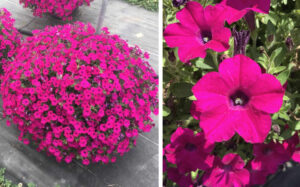
Petunia Itsy Magenta (Credit: Penn State Flower Trials)
Growers, local garden centers, and other plant experts picked those and more for the four-part, best-new-plants series that I compile each January – a good month for gardeners to plan what to plant in the coming season.
I focus on the Best New Annual Flowers of 2023 in today’s installment. In case you missed it, last week’s post covered the Best New Vegetables, Herbs, and Fruits of 2023. I’ll write posts the next two weeks on the Best New Perennial Flowers of 2023 and the Best New Trees and Shrubs of 2023.
Some of the following new annual flowers are available in seeds or plants online and in some plant catalogs. Most also will show up in plant form in local garden centers beginning in late April to early May.
The details:
Petunia Itsy Magenta
Lots of petunias are super-bloomers these days, so it says something when a new variety outscores the field in side-by-side trials.
That was the case last summer at the Penn State Flower Trials in Lancaster County where Director Sinclair Adam says Itsy Magenta clocked in as the best-scoring petunia out of nearly 90 competitors.
Adam picks Itsy Magenta as one of his top new flowers of 2023, citing the variety’s “great blooming ability, compact habit, and clean foliage all season.”
He says the trial plants bloomed non-stop from June to September in a deep-magenta shade.
As the series name suggests, Itsy petunias are smaller-flowered than most petunias and also are mounding, trailing low-growers that are ideal in baskets and pots.
Petunias do best in full sun to light shade.
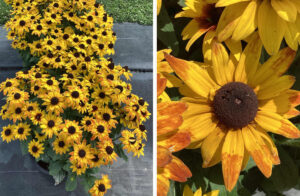
Rudbeckia Sunbeckia ‘Carla’ (Credit: Penn State Flower Trials)
Rudbeckia Sunbeckia ‘Carla’
Adam was also impressed with this new rudbeckia in the German-bred Sunbeckia series.
Sunbeckia ‘Carla’ has large three- to four-inch flowers that are bright gold with tinges of burgundy-red.
Adams says that ‘Carla’ is not only showy (it scored a perfect 5 for blooms in the 2022 Penn State trials), it has a uniform habit and strong stems as well.
It’s also fairly cold-hardy and could survive a milder central-Pennsylvania winter, so don’t yank these at season’s end. Wait to see if new growth appears the following spring.
Plants grow about 32 inches tall, ideally in full sun or light shade.
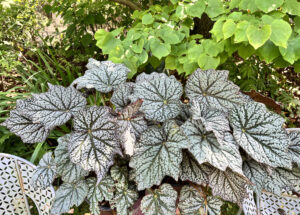
Begonia Lunar Lights ‘Sterling Moon’ (Credit: Plants Nouveau)
Begonia Lunar Lights ‘Sterling Moon’
One of the most striking foliage annuals hitting the market in 2023 is this first entry in a new showy-leafed, cold-tolerant begonia series called Lunar Lights.
‘Sterling Moon’ has big, textural, puckered mint-green leaves that are heavily variegated in silvery-white, making it look like the plant has been nearly covered in snow.
“I love this new begonia,” says Plants Nouveau co-owner Angelina Treadwell-Palmer, who rates ‘Sterling Moon’ as her favorite 2023 new annual. “It makes a lovely patio plant in summer and an indoor plant in winter. The foliage is amazing.”
Similar to Sunbeckia ‘Carla,’ ‘Sterling Moon’ is also cold-hardy enough to survive a mild central-Pennsylvania winter – or a warm microclimate. It’ll be sold as an annual, although another option is potting and growing them inside as houseplants over the winter.
Outside, ‘Sterling Moon’ will do best in part shade, especially in a pot. Plants grow about 30 inches tall and 24 inches wide. Summer flowers are salmon-pink.
Begonia Hula
Another new twist in begonias is PanAmerican Seed’s four-color Hula series, which is novel for its spreading habit.
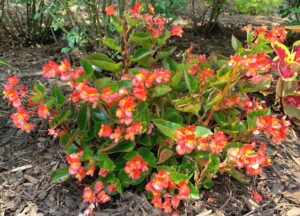
Trailing begonia Hula Red White Bicolor (Credit: George Weigel)
“There’s really nothing like it in gardens today,” says Katie Rotella, spokesperson for PanAmerican’s parent company, Ball Horticultural Co. “It’s more like a Wave petunia, spreading fast to fill in landscapes and garden beds all season long.”
She says Hula begonias will work especially well spilling out of hanging baskets or mixed containers.
The series debuts this spring with four varieties: Red, Blush, Pink, and Bicolor Red White.
Plants grow about 10 inches tall with a two-foot spread in sun or shade.
Begonia Dragon Wing White
Chris Wallen, the head annual-flower grower at the wholesale Quality Greenhouses near Dillsburg, picks another new PanAmerican begonia as his favorite new annual of 2023.
Wallen likes Dragon Wing White, a white-blooming version of the popular bright-red-blooming Dragon Wing, that’s been 20 years in the breeding pipeline.
He says the variety could become an “instant classic. It’s similar to the famous Dragon Wing Red, but with a slightly shorter, wider growth habit. Dragon Wing begonias are practically bulletproof.”
Dragon Wing White grows about 12 to 18 inches tall and wide and grows in all light situations from full sun to full shade… in the ground or in pots.
Begonia I’Conia Lemon Berry (Credit: Penn State Flower Trials)
Begonia I’Conia ‘Lemon Berry’
Penn State’s Adam is a fan of this fourth new begonia, which he describes as “double pink and yellow flowers borne prolifically above dark-green foliage.”
I’Conia Lemon Berry grows about 18 inches tall and blooms non-stop from June to September.
It’s a good choice for a shady container.
Double Impatiens Glimmer
Another new shade-tolerant annual geared for basket and pot use is this double-flowered impatiens from Ball FloraPlant that’s highly resistant to the downy-mildew disease that decimates most older impatiens varieties.
The Glimmer series has rose-like flowers and is debuting in seven colors – Appleblossom, Bright Red, Burgundy, Dark Red, Hot Pink, Salmon, and White.
Plants grow about a foot tall and wide and do best in shade or part shade.
Also new in impatiens for 2023 is a five-variety, foot-tall line of species crosses called Solarscape, which do well in both sun or shade and are resistant to downy mildew.
Because they’re seed-produced, Solarscapes will be less expensive than New Guinea, SunPatiens and most other new types of disease-resistant impatiens.
The line was innovative enough to earn the 2022 Industry’s Choice award given by Greenhouse Grower magazine.
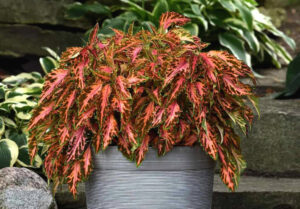
Coleus Premiium Sun Coral Candy (Credit: All-America Selections)
Coleus Premium Sun Coral Candy
Three new annuals were good enough performers in national trials last year to earn All-America Selections national awards for 2023.
The first is coleus Premium Sun Coral Candy, which is the first seed-grown coleus ever to win AAS honors. (The best coleus varieties are typically grown from cuttings of parent plants.)
Coral Candy has narrow, serrated, tricolor leaves (dark green, cream, and bubble-gum pink) on compact plants that top out at about 15 inches.
AAS judges found that the variety holds its color well even in full sun and has a dense, uniform growth habit.
Coral Candy will grow in sun or shade and is ideal for use in pots.

Elephant ears Royal Hawaiian Waikiki (Credit: Plant Haven International)
Elephant ears Royal Hawaiian Waikiki
The second AAS national winner is another eye-grabbing foliage plant with tricolor leaves – a new elephant ears (Colocasia esculenta) variety bred by Dr. John Cho of the University of Hawaii.
Royal Hawaiian Waikiki is the first elephant-ears variety to win an AAS award. It also earned a 2023 National Garden Bureau Green Thumb award as one of the year’s two best new annual plants.
Waikiki has huge glossy green leaves with creamy-white markings in the middle and rosy-pink markings inside of that.
This tropical specimen can be planted in the ground – ideally in a damp or wet sunny area – or it makes a striking stand-alone plant in a big flower pot.
It grows about three feet tall, is extremely heat-tough, and grows in full-sun to part-sun locations.
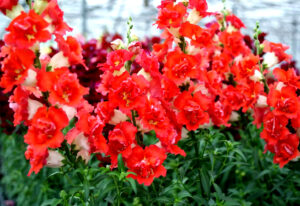
Snapdragon DoubleShot Orange Bicolor (Credit: All America Selections)
Snapdragon DoubleShot Orange Bicolor
The third AAS national winner for 2023 is a new heat-tolerant snapdragon with double bicolor flowers of peachy-orange and white.
Snapdragon DoubleShot Orange Bicolor is part of a new series of mid-sized snapdragons that both tolerate frost at the beginning of the season and keep blooming throughout the heat of summer.
Most older snapdragons can tolerate frosts but go out of bloom when temperatures hit the upper 80s in summer.
AAS judges also liked DoubleShot Orange Bicolor for its strong stems and heavy bloom and noted that the variety makes a good cut flower.
Plants grow 18 to 20 inches tall in full sun to part shade.
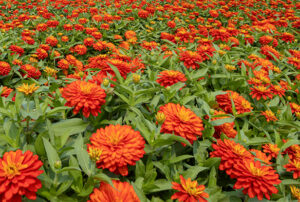
Zinnia Zydeco Fire (Credit: Syngenta Flowers)
Zinnia Zydeco
This new four-color line of zinnias from Syngenta Flowers could give the tried-and-true Profusion and Zahara zinnia series a run for their money with its extra-large flowers.
The double flowers of Zydeco (a seed-grown line) are about 25 percent bigger than the competition on similar bushy, compact, mounding plants that grow 14 to 20 inches tall.
The Zydeco series was good enough to earn the 2023 Reader’s Choice award from Greenhouse Grower trade magazine.
The series comes in four colors: Cherry (rosy-red), Deep Yellow, White, and what’s shaping up as the best-seller of the bunch, Fire, a bright orange-red bloomer.
Zydeco plants are also deer- and mildew-resistant, pollinator-attractive, heat- and drought-tough, and season-long bloomers. They perform best in full sun.
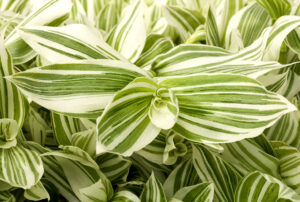
Tradescantia ‘Pistachio White’ (Credit: Green Fuse Botanicals)
Tradescantia ‘Pistachio White’
‘Pistachio White’ is a new tradescantia with bright, heavy, white-and-green variegated foliage – a different option from the traditional rosy-purple, silver, and green tricolor leaves of this plant.
Tradescantia is a trailing plant that makes an excellent houseplant as well as a showy basket plant in a shady outside location in summer.
Greenhouse Grower magazine was impressed enough with ‘Pistachio White’s’ foliage that it gave the plant its Editor’s Choice award for 2023.
The variety also earned a 2023 National Garden Bureau Green Thumb award as the year’s best new houseplant.
It grows about 10 inches tall and spreads about three feet out.
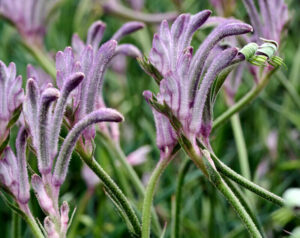
Kangaroo paws Celebrations Carnival (Credit: Monrovia)
Anigozanthus Celebrations
If you’re looking for something unusual, anigozanthus is a tropical plant, nicknamed “kangaroo paw,” that can be grown as an annual in cold climates.
Katie Tamony, the chief marketing officer for Monrovia Nurseries, rates the new three-color line of anigozanthus, called Celebrations, as her favorite new annual-flower introduction of 2023.
“These are like no other anigozanthus on the market,” says Tamony of the novel colors and unusual shapes of the flowers.
Celebrations Carnival has fuzzy, soft-purple flowers, Celebrations Fireworks has teal and green flowers with hot-pink bases, and Celebrations Mardi Gras has bicolor flowers of purple and peacock-blue.
Plants are heat- and drought-tough and grow about 16 inches tall, ideally in full sun to part shade.
Kangaroo paws also make good cut flowers.
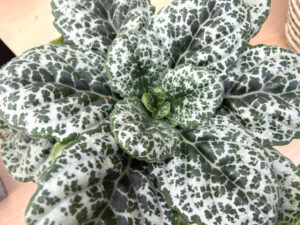
Cape primrose ‘Pretty Turtle’ (Credit: Nancy Knauss)
Cape primrose ‘Pretty Turtle’
Another traditional houseplant that newly retired Penn State Master Gardener coordinator Nancy Knauss likes as a potted outdoor summer plant is a new cape primrose (Streptocarpus) called ‘Pretty Turtle.’
Knauss especially likes the foliage – “uniquely patterned, pale-green leaves spotted with dark-green hues that resemble a turtle shell.”
‘Pretty Turtle’ also produces soft lavender flowers.
It grows best in bright, indirect light indoors and in a protected, shady spot outdoors in summer, “similar to an African violet,” says Knauss.
Plants grow about 10 inches tall.
Canna Cannova Red Golden Flame and Bronze Peach
Ashcombe Farm and Greenhouses co-owner Kerri Laudig likes these two new colors in Ball Ingenuity’s compact, seed-grown series of Cannova cannas.
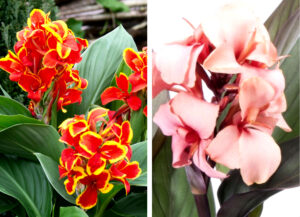
Canna Cannova Red Golden Flame, left, and Bronze Peach, right. (Credit: Ball Ingenuity)
Red Golden Flame is a bright orange-red and gold bicolor bloomer, while Bronze Peach has dark bronze leaves and peach-colored flowers.
“People like these for the tropical look and height in containers,” says Laudig. “They’re easy to winter-over, too.” (Just store the tubers dry in cool place, such as in sawdust, dry peat moss, or wrapped in newspaper in a paper bag.)
Red Golden Flame and Bronze Peach grow three to four feet tall, ideally in full sun. The Cannova series is now up to 10 colors.
Verbena Lascar Orange Lava
Verbenas are spreading, low-growing annuals that generally come in cool colors, such as lavender, rose, and pink.
Selecta One’s new Lascar Orange Lava gives gardeners a new color option with its bright red blooms.
“It’s a garden spectacle, like lava oozing along the ground,” says Ball Horticultural’s Rotella. “It won’t fail to draw attention. It’s a unique, vibrant color for verbenas.”
Lascar Orange Lava grows about a foot tall with a slightly bigger spread. It grows best in full sun and is a good option for a hanging basket as well in the ground.
Read George’s post on the Best New Annual Flowers of 2022







